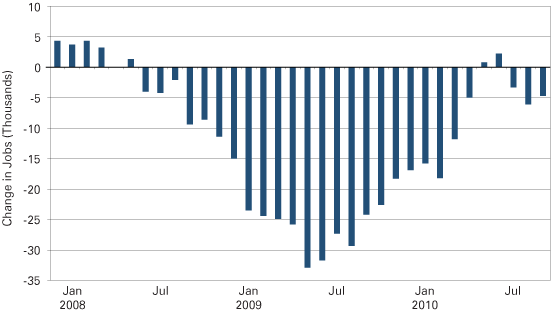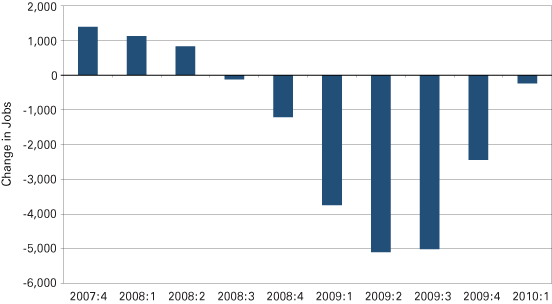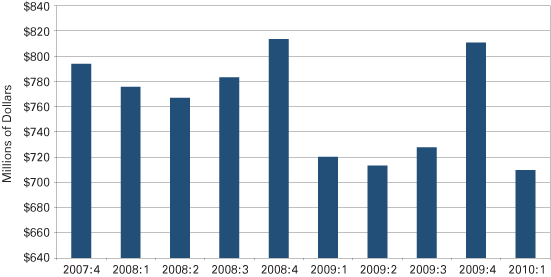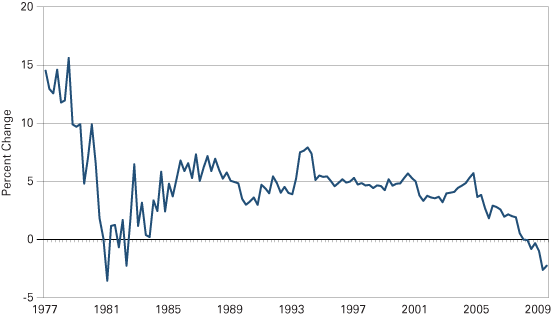Louisville Forecast 2011
Sanders Chair in Business, Indiana University Southeast, New Albany
The national recession officially ended in June 2009, and the middle of 2009 also coincided with the deepest year-over-year job losses locally. Since that time, job losses have subsided, and the Louisville metro area actually saw positive year-over-year job gains for a short time in the middle of 2010. Since then, the nation’s economy hit a soft patch, raising concerns of a double-dip recession. The nation will escape a double-dip recession, but the key question for next year is the impact of national growth on the regional economy.
Last year, our outlook for the Louisville metro was slow growth, elevated rates of unemployment and consumer retrenchment. This year, the region will see continued improvement in the regional economy, but will not return to the labor market conditions that existed at the start of the recession. However, compared to last year we will make noticeable progress. There will be a continuation of economic growth and employment. The region’s unemployment rate will remain somewhat elevated but with a downward trend. Consumers will continue to show their vigilance, and discretionary spending will continue to take a back seat to frugality.
Labor Markets and Employment
Since December 2007, the official start of the recession, the Louisville metro has lost a total of 37,700 nonfarm payroll jobs (see Figure 1).1 Job losses over the official recession dates, December 2007 to June 2009, total 32,500. Despite additional job losses following the recession’s ending date, the region will begin to see a gradual improvement in local labor markets. For example, job changes since the start of the year are only down 200, which is similar to what happened following the 2001 recession.2
Figure 1: Monthly Change in Nonfarm Payroll Jobs in the Louisville Metro, Year-over-Year December 2007 to September 2010

Source: Bureau of Labor Statistics
Some of the most severely impacted sectors have been construction, manufacturing, retail, and transportation and warehousing. Losses in the transportation sector have decelerated as the nation’s economy continues a soft recovery, and manufacturing did see a halt to the severe job losses that occurred early in the recession. Likewise, losses in both retail and construction have slowed.
Employment growth in these severely impacted sectors will depend on both local and national consumer demand. A surge in consumer demand is suspect, but growth in employment will exceed last year’s rates. Recent national reports give more confidence that growth rates in these sectors will be higher than expected and in line with sustainable employment gains.
The professional and business services (PBS) sector has seen recent gains, which can normally be viewed as a barometer of future hiring. However, in this most recent episode, gains in the professional and business services sector have not been followed by sustained gains in total employment. Overall economic uncertainty in the macro-economy and uncertainty in the nation’s capital may be placing headwinds to permanent hiring. Hiring in the professional and business services sector has increased by 6 percent since the start of 2010, for example, likely due to temporary labor services. Overall hiring minus the PBS sector is down slightly at almost 1 percent and has yet to hit a sustained positive trend. Recent reports lead one to believe that the increase in professional and business services sector will be followed by sustained increases in all employment.
Southern Indiana
We will continue to see stability in the labor markets in Southern Indiana. New and continuing claims for unemployment have declined considerably from recession level highs.3 As employment resumes, we will see gradual declines in Southern Indiana unemployment rates. Employment losses have decelerated, and we will now enter a period of job creation (see Figure 2).
Figure 2: Quarterly Change in Payroll Jobs in Southern Indiana, 2007:4 to 2010:1

Note: Includes Clark, Floyd, Harrison and Washington counties.
Source: Indiana Department of Workforce Development
Total wages in the four Southern Indiana counties are down 8.5 percent from the first quarter of 2008 to the first quarter of 2010 and will continue to be a challenge to discretionary retail spending (see Figure 3).4
Figure 3: Total Quarterly Wages for Southern Indiana, 2007:4 to 2010:1

Note: Includes Clark, Floyd, Harrison and Washington counties.
Source: Indiana Department of Workforce Development
Housing and Local Valuations
Since 2004, metro area permits are down 70 percent.5 However, housing permits are beginning to show evidence of small increases. Lower levels of housing permits are desirable from a supply/demand perspective in the area’s housing market. But the decline in permits will continue to impose challenges on those sectors that depend on home construction.
Regional home values remain strained. The FHFA House Price Index for the Louisville metro has now undergone seven consecutive quarterly declines (see Figure 4). This is a first in the history of this index. There were a few non-consecutive declines in the early 80s, but the number of recent declines in the index is unprecedented.
Figure 4: Four-Quarter Percent Change in FHFA House Price Index for the Louisville Metro, 1977:4 to 2010:2

Source: Federal Housing Finance Agency
Outlook
The 2011 outlook for the Louisville metro is a return to job creation. Employment growth will resume but not at higher than average rates. The region will continue to see gradual improvements in the area’s unemployment rate, but the decline will be slow due to an expanding labor force. The consumer will continue to emerge, but frugality will continue to dominate in general. Regional retail will continue to be impacted by these consumer trends, and hence the region’s commercial real estate will see continued challenges. Manufacturing will continue to recover, but significant gains in employment growth are doubtful. Housing will continue recovering, but only at a slow pace.
Overall, the outlook for Louisville is a resumption of economic growth and employment, with a more favorable view now to the upside. We will not return to full employment, but 2011 will be the year where we begin to make noticeable progress on the recovery of lost jobs.
Notes
- Calculation based on Bureau of Labor Statistics data from December 2007 to September 2010.
- Calculation based on Bureau of Labor Statistics data from January 2010 to September 2010.
- Unemployment claim data come from Hoosiers by the Numbers.
- This calculation uses Quarterly Census of Employment and Wages data accessed via STATS Indiana.
- This calculation is based on year-end totals from 2004 to 2009 using the Federal Reserve FRED database.
Also in this Issue…
- Outlook for 2011
- International Outlook for 2011
- U.S. Outlook for 2011
- Financial Outlook for 2011
- Housing Market Outlook for 2011
- Indiana's Outlook for 2011
- Indiana's Agricultural Outlook for 2011
- Anderson Forecast 2011
- Bloomington Forecast 2011
- Columbus Forecast 2011
- Evansville Forecast 2011
- Fort Wayne Forecast 2011
- Gary Forecast 2011
- Indianapolis-Carmel Forecast 2011
- Kokomo Forecast 2011
- Lafayette Forecast 2011
- Louisville Forecast 2011
- Muncie Forecast 2011
- Richmond Forecast 2011
- South Bend and Elkhart Area Forecast 2011
- Terre Haute Forecast 2011




